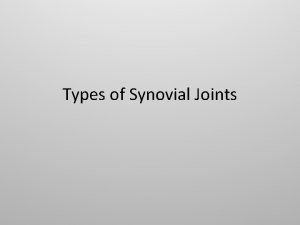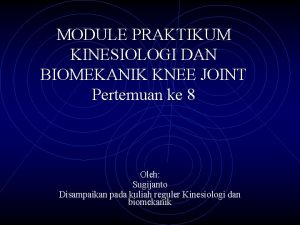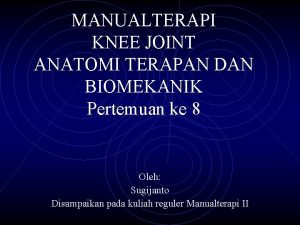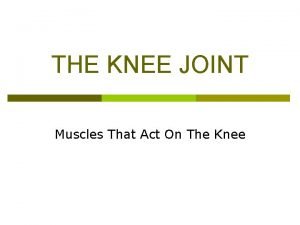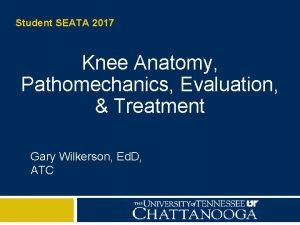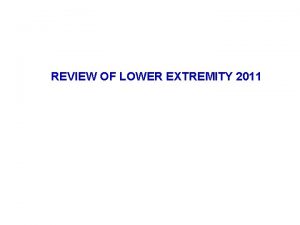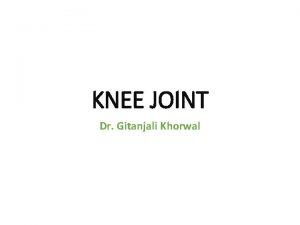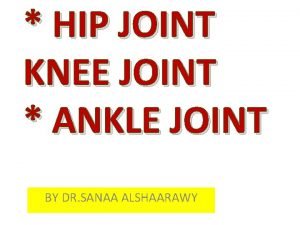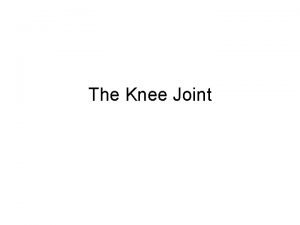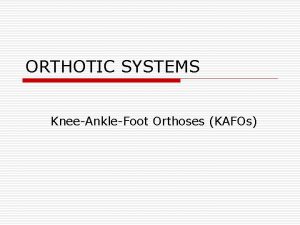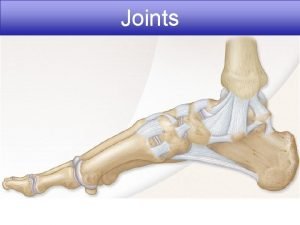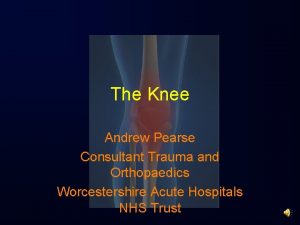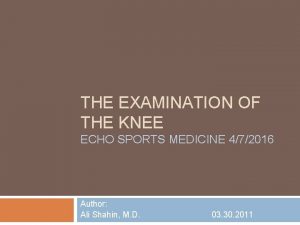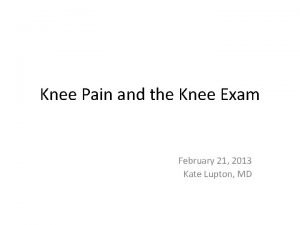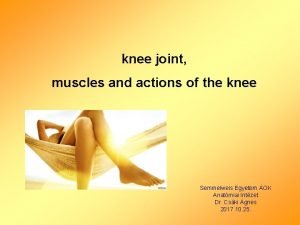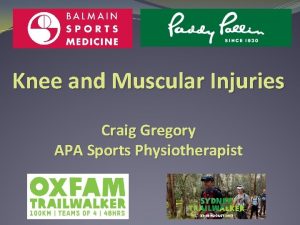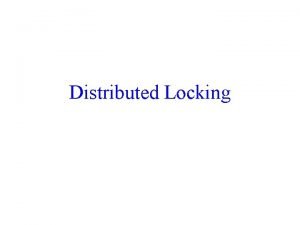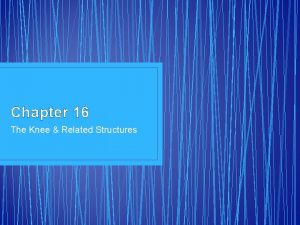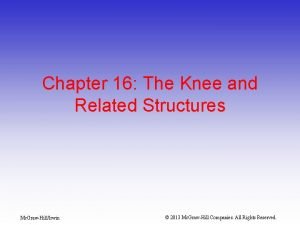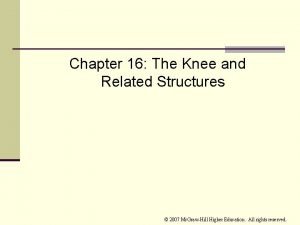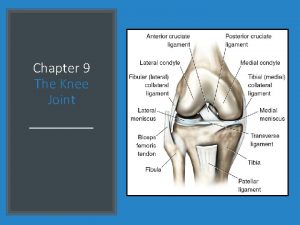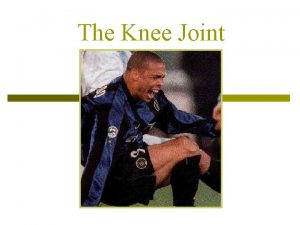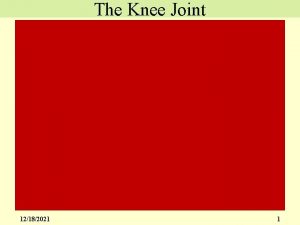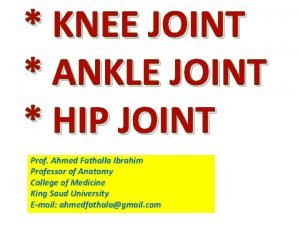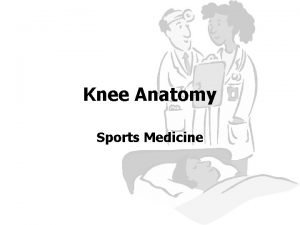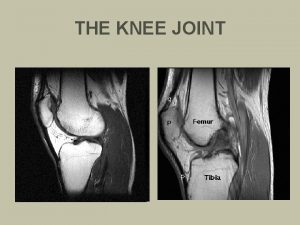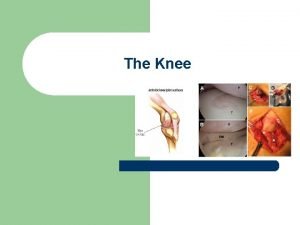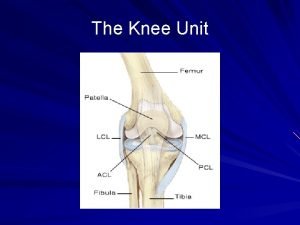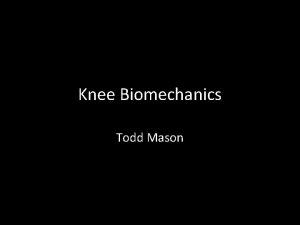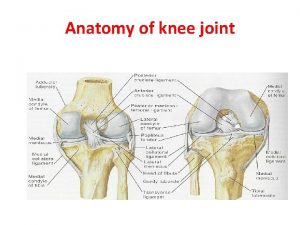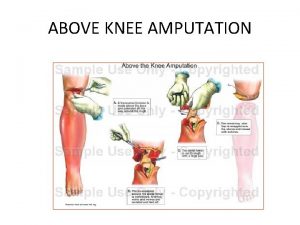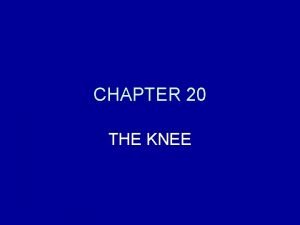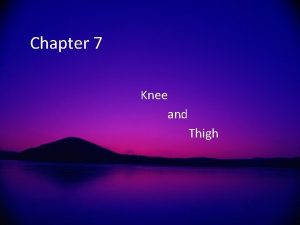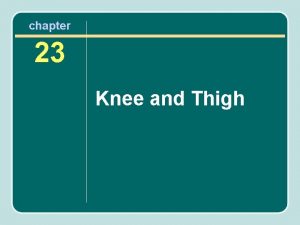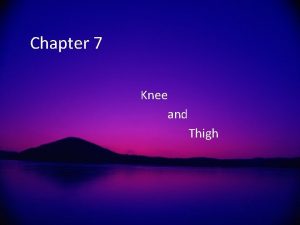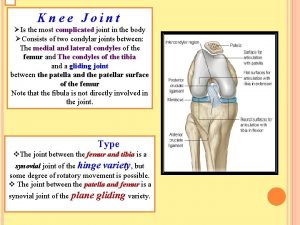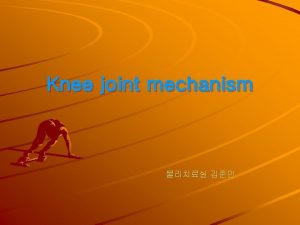Chapter 9 The Knee Joint The Knee Joint































- Slides: 31

Chapter 9 The Knee Joint

The Knee Joint (tibiofemoral) Largest diarthrodial joint in the body Primarily a hinge joint (ginglymus joint) • Sometimes referred to as trochoginglymus joint because internal and external rotation occur during flexion • Some argue for condyloid classification Patellofemoral joint • Classified as arthrodial owing to the gliding nature of the patella on the femoral condyles

The Knee Joint - Tibiofemoral Tibia - Medial • Bears most of the body weight • Enlarged femoral condyles articulate on the medial and lateral tibial condyles (medial and lateral tibial plateaus) Fibula - Lateral • Serves as the attachment for knee joint structures • Does not articulate with femur or patella • Not part of knee joint

The Knee Joint Patella • Sesamoid (floating) bone • Imbedded in quadriceps and patellar tendon • Similar to a pulley • Creates improved angle of pull resulting in greater mechanical advantage in knee extension

The Knee Joint Skeletal Landmarks • Superior (base) and inferior (apex) patellar poles • Tibial tuberosity • Gerdy’s tubercle • Tibial Condyles • Head of fibula

The Knee Joint Skeletal Landmarks • Medial and Lateral femoral condyles and epicondyles • Intercondylar fossa • Adductor tubercle • Intercondylar eminence of tibia • Tibiofibular joint • Apex and

The Knee Joint Skeletal Landmarks for muscle insertions • Three vasti muscles of the quadriceps originate on the proximal femur and insert on the superior pole of the patella • Insertion is ultimately on tibial tuberosity via the large patella tendon • Iliotibial tract of tensor fasciae latae inserts on Gerdy’s tubercle

The Knee Joint Skeletal Landmarks for muscle insertions • Sartorius, gracilis, and semitendinosus insert just below the medial condyle on the upper anteromedial tibial surface • Semimembranosus inserts posteromedial on the medial tibial condyle • Biceps femoris inserts on the fibular head • Popliteus originates on the lateral aspect of the lateral femoral condyle

The Knee Joint Soft Tissue (connective tissue) • Ligaments and muscles provide joint stability, and articular cartilage protects articular surfaces • Tibial (medial) collateral ligament originates on the medial aspect of the upper medial femoral condyle and inserts on the medial tibial surface – protects against valgus forces and frequently injured. • Fibula (lateral) collateral originates on the lateral femoral condyle very close to popliteus origin and inserts on the fibular head – protects against varus forces and infrequently injured MCL Injuries occur commonly, particularly in contact or collision sports Teammate or opponent may fall against lateral aspect of knee or leg, causing medial opening of knee joint and/or external rotation resulting in stress to medial ligamentous structures

The Knee Joint Soft Tissue (connective tissue) Menisci: • Attached to tibia • Medial meniscus - Larger and more open C appearance • Lateral meniscus - Closed C configuration • Deepen tibial plateaus • Enhance stability and protection • Thicker on the outside border and taper down to be very thin on the inside border • Medial meniscus forms a receptacle for medial femoral condyle, and the lateral meniscus receives the lateral femoral condyle Tears often occur due to significant compression and shear forces during knee rotation while flexing or extending during quick directional changes in running

The Knee Joint Soft Tissue (connective tissue) Anterior and Posterior cruciate ligaments • Cross within the knee between the tibia and femur • Vital in maintaining anterior and posterior stability, respectively, as well as rotatory stability • Anterior cruciate ligament Posterior Cruciate ligament (PCL) (ACL) injuries Not often injured • One of the most common serious injuries to the knee • Mechanism often involves noncontact rotary forces associated with planting, cutting, and landing in a valgus position Injured because of direct contact with an opponent or the playing surface

The Knee Joint Soft Tissue (connective tissue) Synovial Cavity • Supplies knee joint with synovial fluid • Lies under the patella and between the surfaces of the tibia and femur Infrapatellar fat pad • Lies posterior to the patellar tendon • Insertion point for synovial folds of tissue known as “plica” • An anatomical variant that may be irritated or inflamed with injuries or overuse of the knee Bursa • More than 10 bursae are located around the knee • Some are connected to the synovial cavity • Absorb shock or reduce friction

The Knee Joint – Range of Motion • Knee Extension to 180 degrees • Hyperextension of 10 degrees or more is not uncommon • Flexion occurs to about 150 degrees • With knee flexed 30 degrees or more: • Internal rotation of approximately 30 degrees occurs • External rotation of approximately 45 degrees occurs

The Knee Joint – Range of Motion Flexion • Bending or decreasing the angle between the femur and leg; characterized by heel moving toward buttocks Extension • Straightening or increasing the angle between the femur and leg

The Knee Joint – Range of Motion External rotation • Rotary movement of the leg laterally away from the midline Internal rotation • Rotary movement of the leg medially toward the midline Neither will occur unless flexed 20– 30 degrees or more

The Knee Joint – Accessory Movement Knee rotary movement “screw home movement” to fully extend owing to the shape of the medial femoral condyle • As the knee approaches full extension, the tibia must externally rotate approximately 10 degrees to achieve proper alignment of tibia and femoral condyles • In full extension, due to close congruency of articular surfaces, no appreciable rotation of knee occurs

The Knee Joint – Muscle Groups (anterior) • Quadriceps muscle group • Extends the knee • Located in the anterior compartment of the thigh • Consists of 4 muscles • Rectus femoris • Vastus lateralis • Vastus intermedius • Vastus medialis

The Knee Joint – Muscle Group Function: The Quadriceps • All attach to patella and then to the tibial tuberosity via the patellar tendon • All are superficial and palpable, except vastus intermedius (under rectus femoris) • Function as decelerators when: • Speed needs to be decreased to change direction • Body needs to be stopped when coming down from a jump • Eccentric contraction during decelerating actions • Controls the slowing of movements initiated in previous phases of the sport skill

The Knee Joint – Muscle Group Function: The Quadriceps • Strength or power may be indicated by vertical jump test • Generally desired to be 25% to 33% stronger than the hamstring muscle group • May be developed by resisted knee extension activities from a seated position • Functional weight-bearing activities such as stepups or squats are particularly useful for strengthening and endurance

The Knee Joint – Muscle Group Function: The Quadriceps Q angle • Central line of pull for entire quadriceps runs from the anterior superior iliac spine (ASIS) to the center of patella • Line of pull of patella tendon runs from center of patella to center of tibial tuberosity • Angle formed by the intersection of these two lines at the patella is the Q angle

The Knee Joint – Muscle Group Function: The Quadriceps • Normally, this angle will be 15 degrees or less for males and 20 degrees or less for females • Generally, females have higher angles due to a wider pelvis • Dynamic Q angles vary significantly during planting and cutting activities • Higher Q angles generally predispose people, in varying degrees, to a variety of potential knee problems, including lateral patellar subluxation or dislocation, patellar compression syndrome, chondromalacia, and ligamentous injuries

The Knee Joint – Muscle Group Insertion: The Pes Anserinus (goose's foot ) Gracilis, sartorius, and semitendinosus join together distally to form pes anserinus • Attaches to anteromedial aspect of the proximal tibia below the level of tibial tuberosity • This attachment and the posteromedial line of pull enable them to assist with knee flexion, particularly once the knee is flexed and the hip is externally rotated

The Knee Joint – Muscle Group Function: The Posterior Muscle Group Posterior - Primarily knee flexion Hamstrings (see Chapter 08: Hip and pelvis) • Biceps femoris • Semimembranosus • Semitendinosus • Popliteus (flexor and internal rotator) • Gastrocnemius (assists in knee flexion)

The Knee (and hip) Joint – Biarticular Muscles • Most effective when either the origin or the insertion is stabilized to prevent movement in the direction of the muscle when it contracts • Muscles are able to exert greater force when lengthened than when shortened • All the hamstring muscles, and the rectus femoris, gracilis, and sartorius, are biarticular (two-joint) muscles • Example - Sartorius muscle • Total length increases as it becomes more effective at flexing the knee when the pelvis is rotated posteriorly and stabilized by the abdominal muscles • Exemplified by trying to flex the knee and cross the legs in the sitting position (one usually leans backward to flex legs at the knees) • A football kicker invariably leans well backward to raise and fix the origin of the rectus femoris muscle to make it more effective as an extensor of the leg at the knee

Skeletal Muscles of the Knee Joint : Rectus Femoris

Skeletal Muscles of the Knee Joint : Rectus Femoris

Skeletal Muscles of the Knee Joint : Vastus Lateralis Muscle

Skeletal Muscles of the Knee Joint : Vastus Intermedius Muscle

Skeletal Muscles of the Knee Joint : Vastus Medialis Muscle

Skeletal Muscles of the Knee Joint : Popliteus Muscle

Skeletal Muscles of the Knee by Action Extension: Agonists • Rectus femoris • Vastus lateralis • Vastus intermedius • Vastus medialis Flexion : Agonists • Biceps femoris (long and short heads) • Semitendinosus • Semimembranosus • Popliteus Internal Rotation : Agonists • Semitendinosus • Semimembranosus • Popliteus External Rotation: Agonists • Biceps femoris
 Fibular head
Fibular head Schede type vertical suspension
Schede type vertical suspension Biomekanik knee joint
Biomekanik knee joint Biomekanik knee joint
Biomekanik knee joint Resting position of knee
Resting position of knee Arthrograms of the knee joint labeled
Arthrograms of the knee joint labeled Semimembranos
Semimembranos Knee joint ligaments
Knee joint ligaments Ligament of head of femur
Ligament of head of femur Coronary ligament
Coronary ligament What is hilton's law
What is hilton's law Popliteus
Popliteus Orthotic knee joint stainless steel ring drop lock
Orthotic knee joint stainless steel ring drop lock Uniaxial joint
Uniaxial joint Andrew pearse
Andrew pearse Drawer test
Drawer test Medial meniscus tear test
Medial meniscus tear test Intracapsular but extrasynovial
Intracapsular but extrasynovial Knee anatomy
Knee anatomy Locking and unlocking of knee joint
Locking and unlocking of knee joint Makenzie milton injury
Makenzie milton injury Knee anatomy chapter 16 worksheet 1
Knee anatomy chapter 16 worksheet 1 Chapter 16 worksheet the knee and related structures
Chapter 16 worksheet the knee and related structures Spool joint vs break joint
Spool joint vs break joint Nuchal ligament
Nuchal ligament Joining methods wood
Joining methods wood Memorandum joint venture
Memorandum joint venture Lamb carcass grading
Lamb carcass grading Condyloid joint and ellipsoid joint
Condyloid joint and ellipsoid joint Hình ảnh bộ gõ cơ thể búng tay
Hình ảnh bộ gõ cơ thể búng tay Bổ thể
Bổ thể
